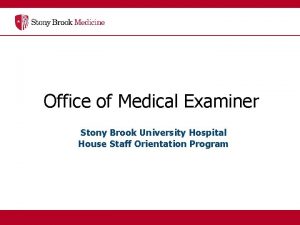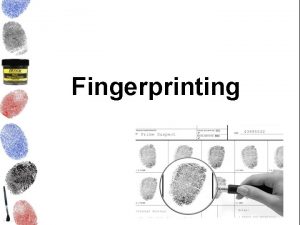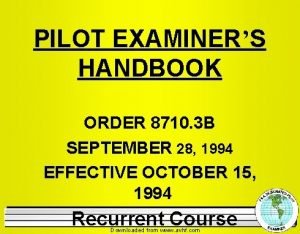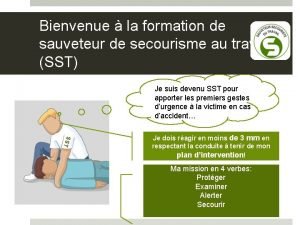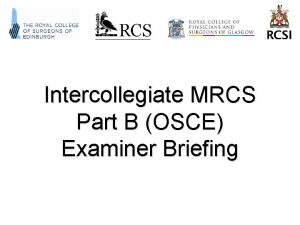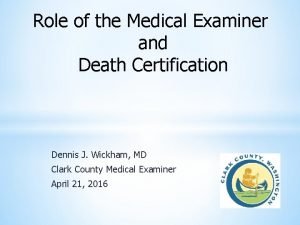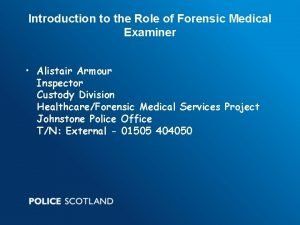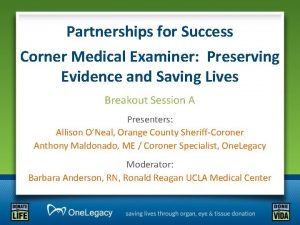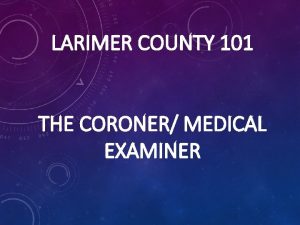The Medical Examiner The Medical Examiner Vs The




























- Slides: 28

The Medical Examiner

The Medical Examiner Vs. The Coroner

The Medical Examiner is a medically qualified government officer whose duty is to investigate deaths and injuries that occur under unusual or suspicious circumstances, and to perform post-mortem examinations. The Medical Examiner is required to have a medical degree, often with additional education in forensic pathology. Typically, The Medical Examiner is appointed to his/her position. The Medical Examiner’s task is to determine cause, time and manner of death.

The Medical Examiner The Coroner are often elected (rather than appointed) officials, and usually do not need to hold any medical qualification. As finders of facts, they use Medical Doctors to determine cause, time and manner of death.

The Medical Examiner What are some of the questions a M. E. is asked to answer? 1) The reason someone dies is called Cause of Death. Ex. Heart attack, disease, stroke, physical injury. 2) The way someone dies is called Manner of Death. a. Natural Causes b. Accidental Death c. Suicide d. Homicide e. Unknown

The Medical Examiner 3) Identification In some cases it is not obvious who the victim is. It is the M. E. job to I. D. the victim. The M. E. will use many of the following to determine I. D.

The Medical Examiner Dental Impressions DNA Skeletal Remains Can you think of any other means of identification?

The Medical Examiner 4) Time of Death During an autopsy, the M. E. wants to determine when the person died. By establishing time of death, a suspect may be proven innocent simply because he/she was not in the place as the victim at the time of death. On the other hand, a suspect my remain a person of Interest if he/she was in the same area at the time of death.

The Medical Examiner How is the time of Death Established? 1) Livor Mortis = Death Color When the heart stops beating blood will settle or pool in the lowest parts of the body.

The Medical Examiner Pooling of blood in the body, known as lividity, will provide clues to how long the person has been dead. Determining time of Death with the use of Lividity. • Lividity begins to show about two hours after death. • Discoloration is permanent after about eight hours. • Between two and eight hours, if the skin is pressed, the color will disappear. • After eight hours, if the skin is pressed, the color will remain.

The Medical Examiner Besides Time of Death, lividity can provide other clues. Because gravity pulls blood toward the ground, livididty can reveal the position of the body at the time of death.

The Medical Examiner 2) Rigor Mortis = Death Stiffness Rigor Mortis is the temporary stiffness of the body after death. Determining time of Death with the use of Rigor Mortis. • Rigor Mortis starts about two hours after death. • Rigor Mortis starts at the head and works its way to the legs. • After 12 hours the body is at it stiffest state. • Generally, stiffness gradually disappears after 36 - 48 hours.

The Medical Examiner • Suppose a detective comes to a crime scene and the victim’s body is not in rigor. What is the time of death? Answer: Less than 2 hours or more than 36 -48 hours. • Suppose a detective comes to a crime scene and the victim’s body is in full rigor. What is the time of death? Answer: Around 12 hours.

The Medical Examiner 3) Algor Mortis = Death Heat Algor Mortis is the cooling of the body after death. Determining time of Death with the use of Algor Mortis. Determining time of death using the cooling of the body (taken from the liver) is sometimes difficult. Many factors contribute to how the body cools. Such as: • Environment Temp • Victim’s clothes, if any • Victim’s Weight

The Medical Examiner Determining time of Death with the use of Algor Mortis. 0 – 12 hr after death 12 – ? hr after death Body loses 1. 4° F per hr Body loses. 7° F per hr These values are just estimates and my vary depending upon many other factors. We can average these values and use 1° F per hour.

The Medical Examiner • During an autopsy the liver temperature is determined to by 92. 6° F. Approximately how long has the body been dead? 98. 6° F – 92. 6° F = 6° F Answer: Since the body cools at a rate of 1° F, 6 hrs.

The Medical Examiner 4) Stomach Contents • In general it takes four to six hours for the stomach to empty its contents into the small intestines. • It then takes another 12 hours for the food to leave the small intestine. • It takes about 24 hours for food to complete the digestion cycle.

The Medical Examiner From this information it can be concluded that: 1) If undigested food is present in the stomach, then death occurred zero to two hours after the last meal. 2) If the stomach is empty but food is found in the small intestine then death occurred at least four to six hours after a meal. 3) If the small intestine is empty but food is found in the large intestine, death occurred 12 hours or more after a meal.

The Medical Examiner 5) Decomposition A corpse decomposes in predictable ways over time that can help determine time of death. Within two days after death: • Cell autolysis (self digestion) begins • Skin turns green/purple from blood decomposition

The Medical Examiner After four days: • Skin starts to blister • The abdomen swells with gas released from bacteria in the intestines. Within six to ten days: • The build up of gases cause chest and abdomen to burst. • Fluids begin to leak from the body openings. • Tissues begin to liquefy. • The skin sloughs off the body.

The Medical Examiner 6) Insects The presence of insects on a body can provide detailed information about the Time of Death. In fact, insects are so useful in crime scene investigation That there is an entire field dedicated to this study and Practice and it is called Forensic Entomology.

The Medical Examiner Within minutes of death, certain insect arrive to lay their eggs on the body. For example, blowflies lay their eggs which soon turn into larva. The larva feed on the decomposing flesh. Sometime after, wasps lay their larva on the body which feed on the blowfly larva. In addition, each stage of decomposition attracts different insects.

The Medical Examiner Let’s look at the Blowfly and how it can help us determine Time of Death.

The Medical Examiner Similar to other insects, blowflies exhibit different stages of development: Eggs Larva

The Medical Examiner Pupae Adult

The Medical Examiner Because we know how long it takes for the various stages of development, forensic entomologists can determine when the blowflies arrived by studying the insects on the corpse. If we know when they arrived we can determine approximate time of death.

The Medical Examiner Blowfly Life Cycle Stage Size (mm) When first appears Phase Duration Characteris tics Egg 2 Soon after death 8 hrs Found in moist areas Larva 5 2 – 5 days 20 – 56 hrs Black mouth Pupae 10 -17 8 – 20 days 4 – 12 days Immobile Adult Varies 21 – 24 days Several Weeks Flight possible visible

The Medical Examiner If a corpse contains blowfly eggs approximate time of death is? Answer: Less then 24 hrs If a corpse contains blowfly larva approximate time of death is? Answer: Between 2 and 5 days. If a corpse contains blowfly pupae approximate time of death is? Answer: Between 18 and 24 days.
 Medical examiner vs coroner
Medical examiner vs coroner Medical examiner
Medical examiner Dr. stephen evans ottawa
Dr. stephen evans ottawa Kevin horn medical examiner
Kevin horn medical examiner North carolina medical examiner toxicology
North carolina medical examiner toxicology Medical examiner vs coroner
Medical examiner vs coroner Accoleds
Accoleds Peee paragraphs
Peee paragraphs Workexaminer
Workexaminer Class c misdemeanor texas
Class c misdemeanor texas Gort-5
Gort-5 The study of fingerprints is called
The study of fingerprints is called Jerry l. crundwell
Jerry l. crundwell Attendance certificate for external examiner
Attendance certificate for external examiner Designated pilot examiner handbook
Designated pilot examiner handbook Kansas assessment examiner's manual
Kansas assessment examiner's manual Coast guard auxiliary test answers
Coast guard auxiliary test answers Sst mission
Sst mission Eduqas english literature a level past papers
Eduqas english literature a level past papers Certified fraud examiner
Certified fraud examiner Ptal california medical board
Ptal california medical board Cartersville medical center medical records
Cartersville medical center medical records Gbmc infoweb
Gbmc infoweb Difference between medical report and medical certificate
Difference between medical report and medical certificate Torrance memorial medical records
Torrance memorial medical records Bổ thể
Bổ thể Chụp phim tư thế worms-breton
Chụp phim tư thế worms-breton Tư thế ngồi viết
Tư thế ngồi viết ưu thế lai là gì
ưu thế lai là gì

